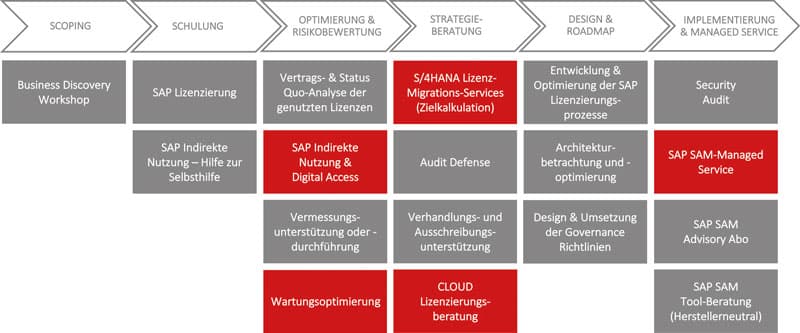New year - recurring challenges


The decision in favor of comprehensive enterprise software such as SAP as a digitization solution is always a fundamental decision with far-reaching consequences: Companies tie themselves down through the effort and cost of implementation and individual customizations. If the manufacturer makes changes to the software or the licensing model, customers ultimately have no choice but to come to terms with them, as a changeover would usually involve disproportionate effort and considerable costs.
Contrary to common expectations, the implementation of SAP is generally not a one-off project for companies: modules of the software that build on each other enable continuous expansion and adaptation to changing business processes, but also an expansion of the digital transformation to additional business areas or business partners.
However, the successive adaptation of SAP to new situations is a coin with two sides. In the long term, SAP enhancements are often complex and expensive. By regularly revising and renewing the software, SAP to a certain extent prescribes the necessary adjustments and sets a framework with its licensing models and their changes. However, the customer is not infrequently confronted with economic hurdles as a result. In this article, we examine the current issues surrounding SAP licensing and contract design. These can be summarized under the headings of cost, compliance and cloud. The new paths that SAP is showing its customers with S/4 Hana and, most recently, with "Rise with SAP" also pose particular challenges. We also look at the associated risks, but also the potential with regard to licensing and contract design.

Cost Management
Avoiding cost traps and optimally negotiating flexibility and conditions: For companies, too, looking to the future is characterized by countless imponderables. As a rule, economic development can only be predicted to a very limited extent. The corona pandemic has once again proven that business conditions can literally change fundamentally from one day to the next. At the same time, the strategic implementation of the digital transformation virtually demands long-term and reliable planning. Due to this contradiction, major challenges also arise again and again for SAP customers.
If planned innovation projects cannot be realized or have to be interrupted or even discontinued, this has negative economic consequences for a company and its development.
In such cases, the budgets for SAP licenses and contracts represent central cost factors. Here, it is a matter of plannability: expansions, both in terms of the scope of software use and the number of users, require an adjustment of the licenses, whereby a reduction in particular is usually not possible, and certainly not at short notice. In addition, adjustments to license terms or product changes, such as the increasing switch from on-premises solutions to cloud applications, also require SAP customers to make fundamental decisions for the future.
Contract negotiations with SAP must be carefully prepared: For example, foreseeable future developments should be taken into account when defining the scope of negotiations and requirements should be bundled in order to achieve better purchasing conditions. Always remember to secure configuration rights or, if possible, swap rights for licenses that will no longer be needed in the future.
In addition, it is important to know the current legal situation before you enter into negotiations. "Old" licenses often have more favorable rights than licenses with the same wording that were procured more recently. For example, professional user licenses in early contracts also have developer rights. There may also be special agreements from older contracts that are advantageous to you. Therefore, contracts with legacy licenses should not be abandoned without a detailed analysis. Last but not least, an inventory in the form of an internal trial survey should definitely be carried out before negotiations begin. As an SAP customer, it is essential to be able to estimate your own requirements as far in advance as possible and to keep a precise eye on actual usage. Only in this way can you avoid unnecessary permanent costs, as well as a proverbial "rude awakening" in the course of an annual SAP system measurement or an audit by SAP.
Ensure your compliance in the most cost-effective way: In a set of rules consisting of GTCs and price and condition lists (PKL), which are now updated quarterly, SAP defines the type and extent to which the use of its software is covered by the purchase of a license. Unfortunately, these definitions are often not unambiguous, but depend on the regulations that applied at the time the license was purchased, as well as any other contractual agreements you may have concluded in this regard.

HiSolutions SAP consulting portfolio: a modular approach.
Compliance
To ensure that the type and scope of the licenses purchased permanently correspond to individual usage, i.e. compliance is maintained, customers are obliged to check software usage as part of annual system measurements and to report this to SAP. For this purpose, user and engine data are measured, supplemented by self-disclosure values if necessary, and transmitted to SAP. This also includes so-called -indirect use, i.e., access (subject to license) by external non-SAP systems or users to SAP's digital core. In recent years, SAP has increasingly sharpened its tools for detecting and evaluating these accesses. It can be assumed that the determination of indirect usage with the help of appropriate tools, such as the Digital Passport, will sooner or later become part of the annual survey.
On the other hand, since 2018 SAP has been offering a model with document-based licensing called Digital Access, which can be used to license access by non-SAP applications to SAP's Digital Core as an alternative to the previous models. If SAP suspects that the agreed compliance is not being adhered to, the actual use can be checked by the SAP Global Audit and Compliance Team (GLAC) as part of a software license audit. This often results in costly relicensing for customers.
Understandably, SAP is striving to continuously improve the precision and scope of this usage survey. With new and constantly evolving analysis systems, SAP is increasingly efficient in identifying deviations from the license terms.

Cloud computing
Cloud first? But please do it in a well thought-out way! With the relocation of data and applications to the cloud, software providers and users are taking the next logical step in digitization. The need for solutions that are also mobile and available from any location is growing continuously. Traditional on-premises solutions are becoming obsolete.
So it's no wonder that SAP is also increasingly turning to the cloud. For customers, there is a strict contractual separation between the two variants, cloud and on-premises. The licensing models on offer are either cloud-only or on-premises-only. Mixed forms that would offer customers both options in one contract are not available. This means that companies have to decide between the two variants and/or purchase both. SAP is clearly focusing almost exclusively on the cloud in the long term and no longer offers many products as on-premises variants.
For many companies, moving to the cloud is a step that involves effort and even more uncertainty. Even the determination of individual requirements over the contract period and the details of the contract design present challenges that can only be mastered with good preparation.
Cloud applications have the advantage for customers that they do not have to operate their own infrastructure with technology and personnel. On the other hand, however, new dependencies arise. For example, once contractually agreed terms and purchase quantities cannot be reduced before the end of the contract, and the more favorable quantity scales do not apply in the event of unplanned additional use. The same applies to product and metric changes during the contract term. With the Cloud Extension Policy, SAP does offer the option of removing the previous licenses from maintenance for a number of applications that are to be moved to the cloud. However, this must be specified before the contract is concluded; it is not possible to exercise this option at a later date.
In order to be able to use cloud applications sensibly, purposefully and at optimal cost, a precise needs analysis and a comparison of the individual requirements with the possibilities of the SAP cloud applications are therefore indispensable before concluding a contract. Since cloud contracts are usually concluded over a longer period - if only because of more favorable conditions - an assessment of the foreseeable further development of requirements over the entire term of the contract should also be made.

Challenge: S/4 Hana
In addition to cost, compliance and cloud, the topic of SAP S/4 Hana is also a challenge for long-standing SAP customers. For several years, SAP has been intensively redesigning and restructuring its offerings. The constantly evolving software finally resulted in the introduction of S/4 as the successor to Business Suite. At the same time, the end of mainstream maintenance of the Business Suite was announced. Even though this decision was postponed, a migration presents itself as inevitable for customers in the medium term.
Additional expense also arises from the fact that S/4 works exclusively with SAP's own Hana database. Moreover, during migration and parallel operation, costs are still incurred for the previous database licenses.
Overall, many users of older software versions assume a disproportionately high effort. It is difficult for them to assess the impact of a required contract changeover and how this should be designed. In this context, those responsible should also seriously examine the possibilities and opportunities given to them with S/4 from a licensing perspective.
Thus, the entire license portfolio can be restructured and converted to the new license model through a contract conversion, which can result in interesting opportunities for cost optimization. In addition to the fact that most packages no longer require additional user licenses, it is particularly noteworthy that the rights for the less expensive user types have been significantly expanded. In the event of a contract conversion, the significantly less expensive user types "Functional Use" and "Productivity Use" can thus be used in many cases - of course, this must be preceded by a precise analysis of the usage in order to avoid any surprises later on.
On the other hand, it can make sense to take the existing licenses (and associated usage rights) with you into the new S/4 world in the form of a "product conversion" - especially if the previously existing licenses and contracts contain favorable usage rights or special agreements that are already optimally tailored to the company's needs.
An intensive professional examination of the licensing of SAP S/4 Hana against the background of one's own situation and the further development of the company is therefore absolutely necessary. In addition, in the course of the S/4 migration, the move to the cloud is often the focus of the changes.

Rise with SAP
Everything in the cloud? Since the beginning of 2021, SAP has been offering its customers a new form of cloud transformation in the form of a complete package with Rise with SAP. Unlike SAP's previous cloud offerings, which only ever address individual problem solutions, Rise offers a shift of the entire ERP software to the cloud as software as a service: Whereas customers previously had to buy the licenses for their ERP software, Rise with SAP is a pure subscription model. In effect, the customer goes from being the owner to being the tenant.
There are advantages and disadvantages associated with this: SAP emphasizes the cost reduction and flexibility of the model from a licensing perspective as well, because the customer does not have to commit to a specific distribution of licenses to specific usage from the outset. The customer can opt for the Public or Private Cloud Edition. The latter can be customized more flexibly, while the Public Cloud Edition offers standards based on best-practice models. For both editions, the customer acquires, among other things, Full Use Equivalents (FUE) for the use, which can be flexibly distributed to the various types of use.
Nevertheless, typical restrictions from SAP cloud contracts also apply to Rise: It is not possible to reduce the scope of services (and thus the ongoing costs) during the term of the contract, and subsequent extensions in scope that were not already agreed at the time the contract was concluded have no effect on discounting. Here, too, customers are therefore well advised to obtain clarity about their needs and future business development before signing a contract. Incidentally, Rise also offers the option of discarding old ballast via the Cloud Extension Policy - but again only before signing the contract.

SAP SAM Consulting
Identify risks early, avoid dangers, seize opportunities: The three big Cs as well as S/4 and Rise present companies with challenges that, in many cases, they cannot overcome on their own. HiSolutions has been supporting companies for over 20 years in setting up and organizing professional license and software asset management (SAM). HiSolutions' SAP license experts with many years of experience have successfully advised many companies from almost all industries, from medium-sized companies to large corporations as well as the public sector, in all questions of SAP license optimization. In free discovery workshops and with the help of individual analyses and consulting, HiSolutions' experts develop appropriate strategies and concepts together with and for their customers. Licenses and maintenance as well as cloud contracts are optimized. Often, innovation projects can be financed in this way, even without an additional budget.
Through regular, partially automated or tool-supported proactive analyses, HiSolutions prepares SAP customers specifically for the annual system measurement. In this way, companies can identify deficiencies at an early stage, take targeted countermeasures, and avoid license audits. By means of SAP SAM tools, whose selection, introduction and optimization HiSolutions accompanies, further optimization potentials can be developed if necessary.
In addition, the SAP licensing experts support their company in selecting the appropriate SAP cloud offering. Based on the analysis of requirements and in-depth consulting on contracts, conditions and options, HiSolutions enables the development of a licensing strategy that is optimally tailored to the company's individual needs. Cost savings are also usually achieved with SAP S/4 Hana and Rise with SAP - through independent consulting and support in contract negotiations. Last but not least, HiSolutions also offers its customers professional SAP licensing consulting as well as the performance of regular system measurement as a customized external service.




